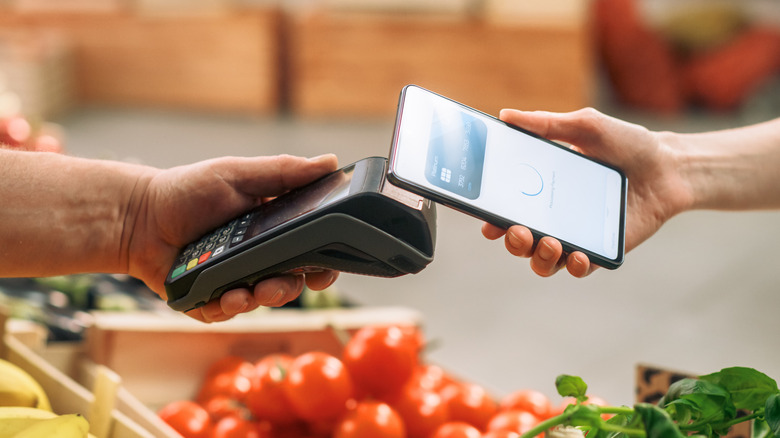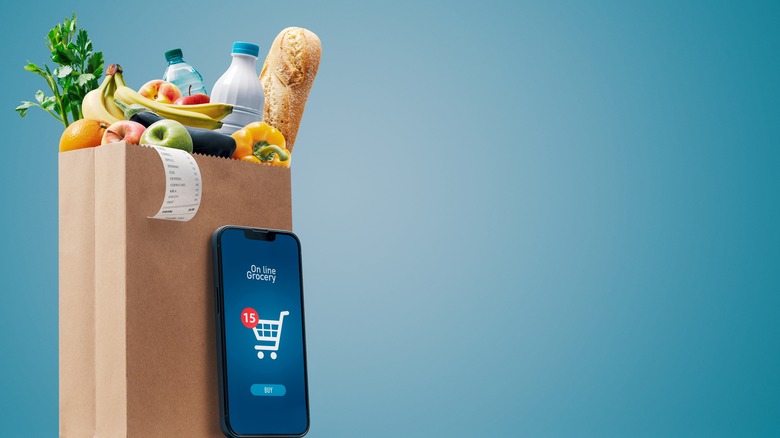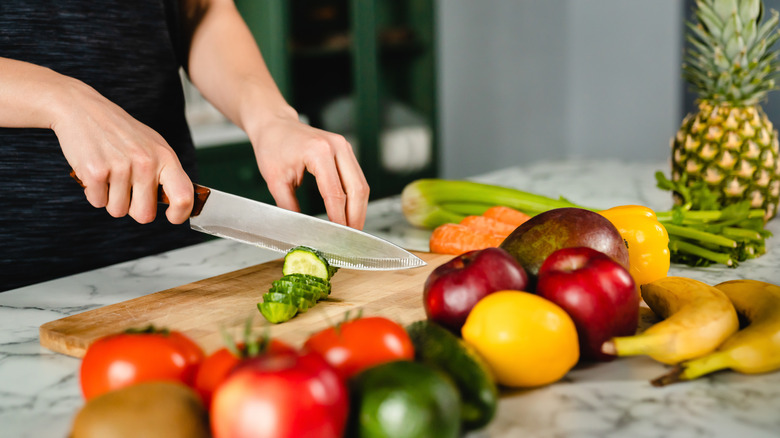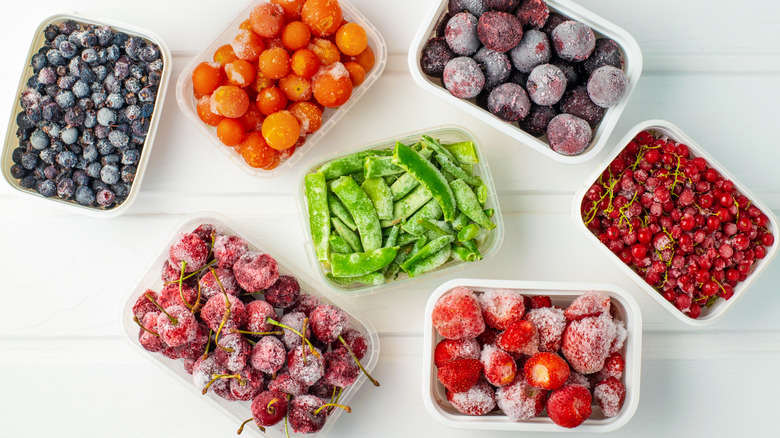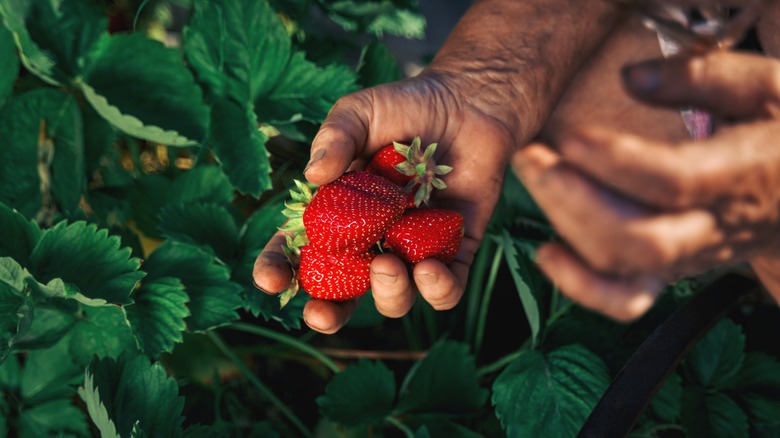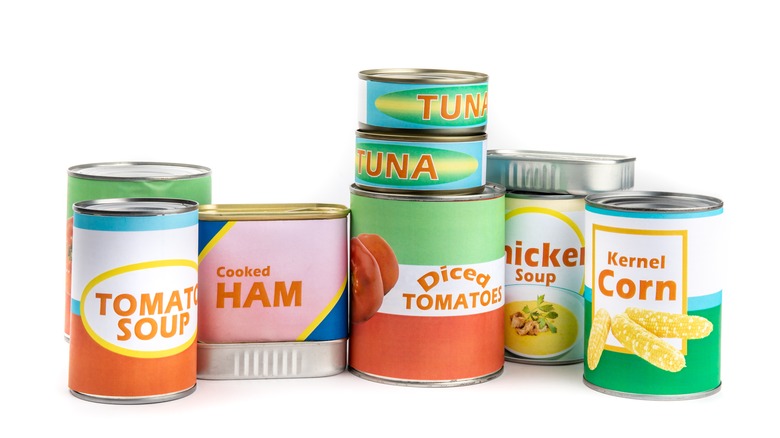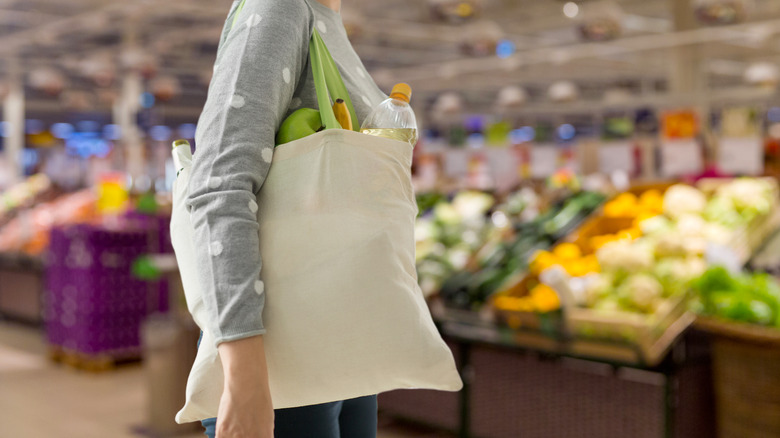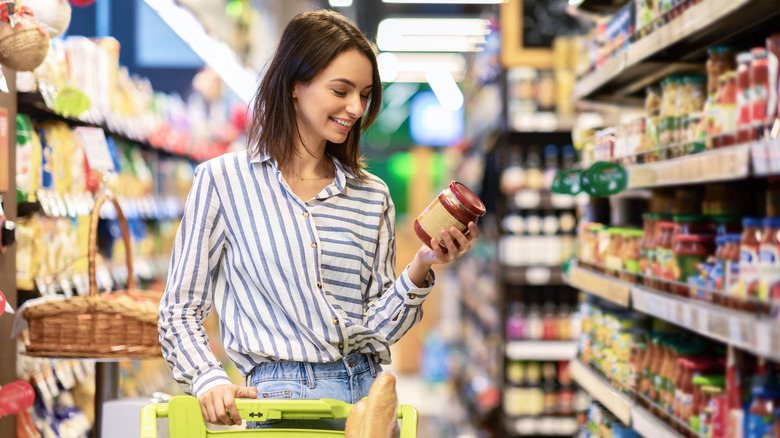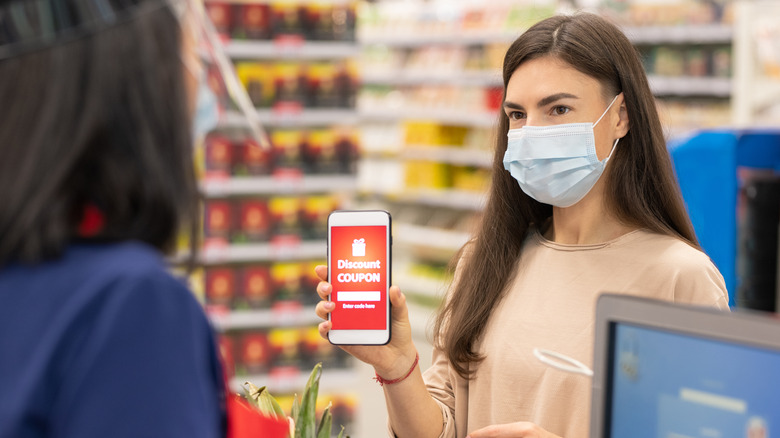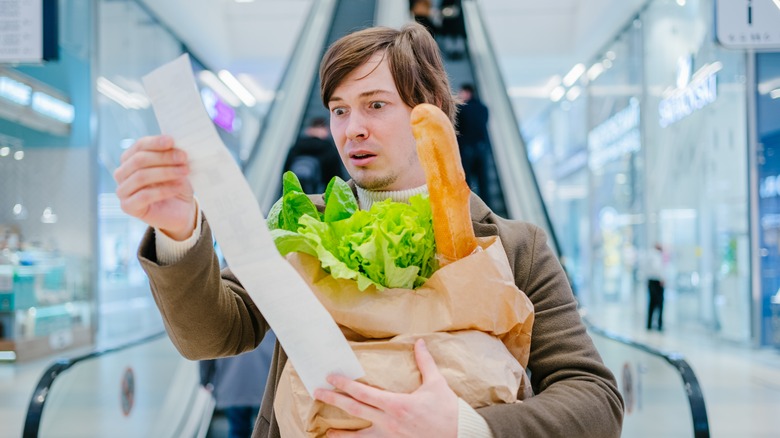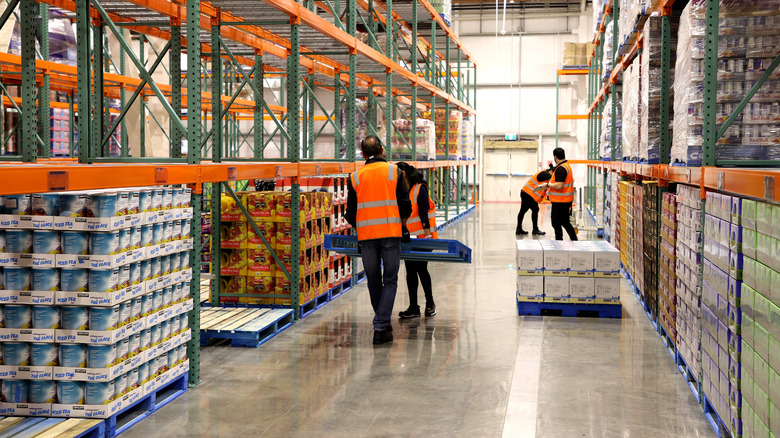14 Ways You're Spending More At The Grocery Store
We may receive a commission on purchases made from links.
Grocery prices are through the roof, with some estimates showing an increase of 12% throughout 2021 (via CNN). At this point, if you're not actively saving money on groceries, you're losing money. However, there are plenty of money-saving tips and tricks that can help you avoid the pricey consequences of food inflation.
Part of the problem for consumers is that grocery stores are simply not there to help you save money. They are a business, so the company actively implements money-making strategies, like adding candy to the front of the grocery store aisle. Keep in mind that company offerings advertised as money-saving opportunities are often designed to do just the opposite. Coupons for specific items, for instance, are a great way to save a few dollars — but only if you already had that item on your grocery list. If store coupons are tempting you to buy items that you wouldn't normally purchase, then they're really fulfilling the purpose of making money for the company, not saving money for you. However, by remaining aware of deceptive marketing tricks and implementing useful savings tips, you do not have to fall victim to rising grocery bills. It may take a little extra effort, but there are plenty of ways you can keep from spending more at the grocery store.
1. Not signing up for rewards
Most grocery stores offer some form of rewards program, and when you sign up for them, you'll save on a small percentage of each purchase. Target, for example, has Target Circle. This program automatically gives you 1% off everything purchased at Target. That may not sound like much, but consider this: As the USDA reports, households spent between $4875 and $13973 on groceries in 2021. That 1% could turn into savings of between $48.75 and $139.73. While this won't pay your rent or college tuition, it could mean a nice dinner out on the town, or an extra contribution to your retirement fund.
Other grocery stores, such as Kroger, offer "fuel points." When you spend money at Kroger grocery stores, you earn points, which saves you money on gas. These savings can help keep your monthly gas expenses down if you drive a car. In fact, it's a good idea to sign up for the rewards program of any store you shop at regularly, even if it isn't grocery-related.
It's important to note that your grocery store's rewards program is not the same thing as its credit card. Although company credit cards can be tempting, as they often offer a hefty discount on your first purchase, these cards often come with an incredibly high interest rate, which can cause you to ultimately lose money if you don't pay off your initial purchase in a timely manner.
2. Buying processed food staples
Buying processed staples has become a grocery store mainstay. Most people don't even consider the financial consequences of buying processed foods. But the truth is, purchasing non-processed items can often save you a lot of money. Take hard-boiled eggs, for example. At Target, two pre-prepared hard-boiled eggs cost almost half the price of six non-hard-boiled eggs. Buying six prepared eggs, rather than purchasing the half-dozen raw eggs and preparing them yourself, would cost you an extra $6.
Even basic items such as sliced and shredded cheese can make a big difference. As the blog Thriving Home points out, the price difference between buying a single 8-ounce bag of shredded cheese and its equivalent in block cheese can be astounding. You can shred the block cheese yourself and save half the money.
Of course, this may not always be the case, but it is worth checking the prices at your grocery store the next time you reach for a package of sliced American singles. Additionally, even if you end up with more, you can often freeze items to save for later. This way, you save money, and you do not have to purchase items as often. It's a win-win!
3. Buying precut fruit and vegetables
Similar to buying processed staples, buying pre-cut fruit and vegetables is a surefire way to spend more at the grocery store. Sure it saves you a few minutes, but that saved time comes at a hefty cost. Vice did some price comparisons at both national and local grocery stores, and their findings were eye-opening.
For items such as butternut squash, they found the pre-cut squash cost more than an additional $3 per pound. Considering the price when buying whole was only $1.29, that's a significant increase. Likewise, pineapple costs an extra $2 per pound when bought pre-cut. While, arguably, pineapple and butternut squash are more tedious to prepare when compared with other fruits and veggies, the price difference actually did not decrease when it comes to other produce. Prepared broccoli, lettuce, onions, and peppers were all much more expensive than their uncut counterparts. While pre-cut fruits and veggies are still a great option for those with mobility differences, if you are able, taking the extra few minutes to cut your produce can add some serious money back into your wallet.
4. Only buying fresh produce
Many people fall into the trap of only wanting to purchase fresh produce because it is believed to be better than buying frozen, but the truth is that this is not always the case. According to Healthline, when it comes to most fruit and vegetables, purchasing frozen can actually add to their nutritional value. This happens for a number of reasons. First, produce meant to be frozen is typically harvested when fully ripe and developed, whereas fresh produce must be harvested early to help it last longer. Additionally, because the freezing process will preserve it, frozen produce is not typically treated with additional chemical preservatives. While freezing produce also has its downsides as well, the differences between the nutritional value of frozen and fresh produce are ultimately very slight.
All of this is great, but the reason we are here is to save money. Frozen fruits and vegetables will save you a lot of money compared to their fresh counterparts. For example, at Target, 12 ounces of fresh broccoli florets cost $1 more than their frozen counterpart. Buying frozen can be a good way to save money if you still want to buy pre-cut fruits and vegetables — you can get your sliced butternut squash without paying the exorbitant extra fee. While freezing can alter the texture of some fruits and vegetables, if you are cooking with them, this will not always make a difference in the end result.
5. Not shopping seasonally
Similarly to only buying fresh produce, not shopping for your produce seasonally will cost you more. All fruits and vegetables have a season. While Americans have gotten used to every product in their grocery stores being available year-round, if you are not watching the price tags, you may not notice the ebb and flow of prices based on their seasonality.
As the USDA shows, produce such as strawberries have massive seasonality price shifts. They are typically in season during the summer, during which time there is a noticeable price drop. During the fall and winter, the price spikes. This trend has repeated for more than three decades.
We know strawberries are delicious, but it is worth keeping in mind when they are in season, so you get the best price. This goes for other produce as well. Citrus season is from November to March (via the UCDavis Center for Nutrition in Schools). Winter squash is in season, you guessed it, during the winter (via The Washington Post). There is typically something in season during any given period, and so if you follow seasonal trends, it will help you save money, as well as enjoy the best quality produce. If you really want an out-of-season fruit or veggie for a recipe, consider buying frozen to help ease the seasonal price hike.
6. Not buying generic
If you are not buying generic brands, you might be paying more for the brand name alone. Name-brand products may have a reputation for quality, but the price isn't always worth it. According to NBC, some name brands cost up to 70% more than their generic counterparts. That's a pretty hefty price tag just for a recognizable logo. And while it's true that some off-brand foods aren't as healthy or nutritious as name-brand selections, some of them are just as good, if not better.
Consumer Reports put several name-brand and generic products to the test. They found that many items were really a toss-up between the name brand and the store brand, such as granola bars, peanut butter, and even Greek yogurt. As Consumer Reports explains, they do not always taste exactly the same, but they do taste comparable. Additionally, many store-brand items are made by name-brand competitors, so there's really no reason to spend the extra money if both products are made by the same manufacturer.
Despite the pros and cons of name-brand vs. generic products, some people simply prefer buying generic. For example, according to Business Insider, Costco's Kirkland brand has an incredibly loyal following. Plus, grocery stores such as Aldi and Trader Joe's are able to keep prices down by offering predominantly house brands, which are both affordable and delicious.
7. Not sticking to your list
Make a list and check it twice! It can be hard to go to the grocery store and only get what is on your list. But for your wallet's sake, it's important to stay strong. One of the ways grocery stores get you to spend more is by relying on impulse buying. They do this in very strategic ways. As Shopify explains, grocery stores will often pair related items on displays, such as cones near the ice cream, to get you to buy more. The layout of most grocery stores is also designed to entice you to spend money. As Regained Wellness notes, pantry staples are often placed in the back, making sure consumers must walk by other alluring items to get to what they actually need. Bakery items can be placed near the front to tempt buyers. But once you're aware of these strategies, you'll be able to recognize and resist them the next time you get off-task at the grocery store.
If you are a person who finds it difficult not to give in to impulse buys, consider figuring out your grocery budget ahead of time and purchasing only with cash instead of a card. This means that you'll only be able to buy what fits into your cash budget. If you've wracked up extra items by the time you make it to the check-out, you'll need to get rid of your impulse foods in order to afford the rest of your haul.
8. Not bringing your own bags
There are multiple reasons not bringing your own bags is going to cost you money. The first and most obvious is that some stores charge you for both paper and plastic bags. Discount grocery store Aldi, for example, was an early adopter of this in the United States. Now it is becoming more common, with chains such as Walmart introducing paid bags at the start of 2023 (via Yahoo!). While the individual bags don't cost much, that extra expenditure does add up.
Additionally, skipping the giant grocery cart and filling only your own tote bags will limit how much you ultimately buy. According to Slate, grocery carts have grown immensely since they were introduced in the 1900s. While there are competing theories as to why they have gotten so large, one clear result of the size increase is that people buy more food. According to Today, one study showed that larger grocery carts led to a 40% increase in overall purchases. Bringing your own bag will help curb this, as you will only take what you can reasonably carry. Plus, you will be eliminating some single-use items, which are better for the environment, so it makes for a good choice all around.
9. Not price checking
One of the easiest ways to save money on groceries is to check local stores' prices. With so many stores offering online shopping now, you can check the prices before you even have to step foot in the door. One of the reasons you should do this is to find the cheapest prices of the items you are looking for — and not just the staples. As Today mentions, many grocery stores will offer staples at a lower price to bring you in and then raise prices elsewhere, causing you to spend more despite your best efforts.
The other reason is many grocery retailers will price match. Companies such as Walmart and Target will lower their prices to match those of competitors. Target will do this both online and in stores. If you know who has the best prices and who offers price matches, you can compare and figure out where it is truly cheaper to get your groceries.
Plus, keeping yourself in the loop when it comes to the pricing at different stores means you'll be more likely to notice if a store is offering online or in-store only discounts and coupons. Once you know about them, you can plan your next shopping trip accordingly.
10. Not stocking up during sales
We all know sales are one of the easiest ways to save money on a product. As mentioned, it is worth checking for both online and in-store sales in order to get the best price. If you find a sale on an item you use on a regular basis, it is worth stocking up on that item during the sales period. This is particularly useful for shelf-stable items such as flour, dry goods, and canned goods, but it can be applied to other things. Butter, for example, freezes well, as do many breads, shredded cheeses, fruits, and vegetables.
This is one of the rare times it is worth it to spend more on your current shopping trip to save you time and money down the line. As long as you do not overbuy and avoid throwing any of the additional food away, you can reap the financial rewards of the sale long after the end of the promotional period.
It is also worth it to learn the sale code of your favorite stores. For example, according to Business Insider, the last few digits of a Costco price will tell you if it is likely to drop any further or not. Other stores such as Target put categories on sale on different days of the week, something to be mindful of when planning a shopping trip.
11. Buying for price over volume
This is a common marketing ploy that grocery stores use to get you to spend more. For example, if you go to a store and see one bottle of soap for $3 and one for $2, the initial response is to think the $2 one is cheaper and reach for that. But that does not take into account the product you will get. To do this, you want to find the item's price per unit.
The price per unit is easy enough to calculate. You simply take the unit of an item — for example, ounces, pounds, or cans — and the number of items contained in the packaging, and divide it by the price of the item. This will show you how much you are being charged per unit of that item. For example, if the $3 bottle of soap is 12 oz, and the $2 bottle is 8 ounces, they actually cost the same amount. And if the $3 is 16 ounces, it is actually cheaper in the long run than the $2 bottle.
You can either do the math yourself, download a unit price app, or shop at a store such as Costco, which advertises the unit price right on its labels.
12. Going shopping too often
If you are one of those people who goes to a grocery store every day to shop, it may be time to reconsider. Aside from the amount of time it takes and the gas and transportation costs, the more often you shop, the more likely you are to end up with food you either did not need or will completely forget about. The best way to save money is to simply not put yourself in a position to spend it. There are plenty of meals you can make even when you have "nothing" in the house.
Target has been especially effective in drawing its customers in time and time again to make impulsive purchases. It has added Starbucks into many of its stores, and entices you with eye-catching displays featuring fun trinkets and decorative items the moment you walk inside. Many people have seen the popular internet jokes about going into Target for one thing and coming out with five items, none of which you came for (via Cosmopolitan). Others joke about a trip to Target as an event to look forward to. While Target's marketing strategies have been successful, they're ultimately just a way to keep you spending money. Do not fall victim, and try to keep your grocery shopping limited to when you actually need groceries.
13. Not joining a wholesale grocery
Some people might be hesitant to join a wholesale grocery store due to the upfront cost. While it is true you are paying for the privilege to shop there, if you are buying a lot of food or feeding a lot of people, it is likely that membership, like the Costco membership, will easily pay for itself. Magnify Money found that buying in bulk from wholesale retailers can have products an average of 25% cheaper than non-bulk retailers. That is a pretty significant saving. Furthermore, with the average family spending thousands of dollars on groceries each year, that price of membership can be earned back quickly.
These wholesale stores keep prices so low not just by stocking bulk products, but also by creating a solid reputation that doesn't revolve around aesthetics or diverse brand options. According to Business Insider, Costco does it by using an unadorned store design, not spending on traditional advertising, and offering their house brand prominently.
Of course, paying attention to what you are buying from a wholesale store is always important. For example, there is no reason to buy large quantities of perishable goods if you are not going to use them or have room to store them. But getting a wholesale membership can save you big time for things you can keep and items you frequently use.
14. Not using rebate apps
Finally, if you have ever wanted to be paid to go shopping, now is your chance. There are plenty of apps out there today, such as ibotta, that allow you to upload copies of your receipts in exchange for rebates. It is kind of like getting a coupon or a sale after the fact. Additionally, as NerdWallet mentions, sometimes these apps give you additional coupons for even more savings.
It is true that by doing this, you are ultimately selling your data. But large companies like Google are already tracking your purchases, without offering anything in return (via CNet). If you're comfortable doing so, you may as well get ahead of them so that you can save money here and there. Using a rebate app allows companies to follow market trends and make sure you get some money back on each of your grocery purchases. While it may not make a huge impact, you will notice the rebates adding up over time.
